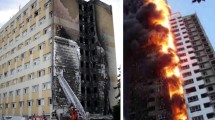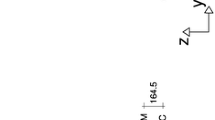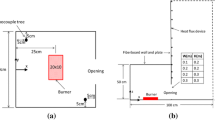Abstract
This paper reports results of experiments and numerical modeling for fires in small-and medium-scale enclosures in underventilated conditions resulting in flame exhaust to the atmosphere. Delays from ignition to the occurrence of a stable flame outside the enclosure were measured experimentally for three types of fuels (methane, propane, and propylene) with a specified fuel supply rate. Characteristic scales dependent on fuel supply rate, fuel source location, compartment geometry, and vent opening parameters are introduced and used to establish a unified nondimensional dependence of the flame exhaust time on fuel flow rate. For the smallest and largest enclosures used in the experiments, three-dimensional numerical calculations of the dynamics of fire development are performed by large eddy simulation. Calculated reaction rate isosurfaces are presented, which demonstrate the compartment fire evolution and its oscillations after exhaust into the atmosphere. It is shown that the calculation results agree qualitatively with experimental observations and that the flame exhaust times are in good agreement with the experimental correlation.
Similar content being viewed by others
References
G. Cox (ed.), Combustion Fundamentals of Fire, Academic Press, London (1995).
J. G. Quintiere, Fundamentals of Fire Phenomena, Wiley (2006).
A. Yu. Snegirev, G. M. Makhviladze, V. A. Talalov, and A. V. Shamshin, “Turbulent diffusion combustion under conditions of limited ventilation: flame projection through an opening,” Combust., Expl., Shock Waves, 39, No. 1, 1–10 (2003).
A. V. Chamchine, T. L. Graham, G. M. Makhviladze, et al., “Experimental studies of under-ventilated combustion in small and medium-scale enclosures,” in: Proc. 4th Int. Seminar on Fire and Explosion Hazards, Londonderry, UK (2003), pp. 97–107.
A. V. Chamchine, G. M. Makhviladze, A. Yu. Snegirev, and T. L. Graham, “Interpretation of small and medium scale experiments with an enclosed burner fire,” in: Proc. 10th Int. Fire Science and Engineering Conf. (INTERFLAM2004), Vol. 1, Edinburgh, UK (2004), pp. 73–81.
A. P. Zykov, S. E. Yakush, and G. M. Makhviladze, “Flame exhaust in compartment fires,” in: European Combustion Meeting, Louvain-la-Neuve, Belgium (2005). CD-ROM Paper No. 217.
P. Moin, “Advances in large eddy simulation methodology for complex flows,” Int. J. Heat Fluid Flow, 23, No. 5, 710–720 (2002).
W. P. Jones, “Large eddy simulation of turbulent combustion processes,” Computer Phys. Commun., 147, Nos. 1–2, 533–537 (2002).
K. B. McGrattan, H. R. Baum, G. P. Rehm, et al., “Fire dynamics simulator (Version 4),” Technical Reference Guide,” Preprint NIST IR 6783, National Institute of Standards and Technology, New York (2003).
K. B. McGrattan, G. P. Forney, J. E. Floyd, et al., “Fire dynamics simulator (Version 4),” Users Guide, Preprint NIST IR 6784, National Institute of Standards and Technology, New York (2003).
Author information
Authors and Affiliations
Additional information
__________
Translated from Fizika Goreniya i Vzryva, Vol. 42, No. 6, pp. 112–120, November–December, 2006.
Rights and permissions
About this article
Cite this article
Makhviladze, G.M., Shamshin, A.V., Yakush, S.E. et al. Experimental and numerical study of transient compartment fires. Combust Explos Shock Waves 42, 723–730 (2006). https://doi.org/10.1007/s10573-006-0107-6
Received:
Revised:
Issue Date:
DOI: https://doi.org/10.1007/s10573-006-0107-6




